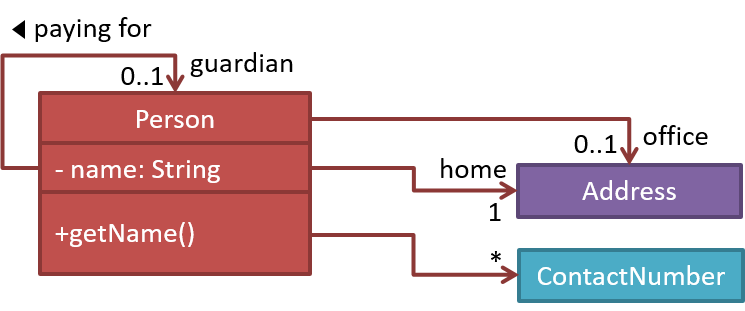Team Project (tP):
Week 8 [Mon, Aug 9th] - Tutorial
1 Exercise: interpret a class diagram
- Do the following exercise as directed by the tutor.
Explain Class Diagram
Explain the associations, navigabilities, and multiplicities in the class diagram below:

2 Exercise: draw an object diagram
[Image source: this article]
That is why we have structured these tutorials to get everyone to practice this skill so that your first few (not-so-good) diagram drawing experiences happen in the tutorial, not in an interview or during your internship.
Note the following:
- Draw on paper or on a whiteboard or use a free-hand drawing software (e.g., Bamboo paper). If latter, do not use UML software or predefined shapes.
- For the same reason, don't use rulers.
- When the tutor asks you to, take a screenshot or a photo of the drawing and post in the tutorial workspace document.
- There are mobile apps (example) that can take a photo of a document and and convert it to a high-quality scan.
- Do the following exercise while noting the info in the box above.
Draw an Object Diagram for the Class Diagram (Person-Guardian)
Suppose we wrote a program to follow the class structure given in this class diagram:

Draw object diagrams to represent the object structures after each of these steps below. Assume that we are trying to minimize the number of total objects.
i.e. apply step 1 → [diagram 1] → apply step 2 on diagram 1 → [diagram 2] and so on.
-
There are no persons.
-
Alfredis the Guardian ofBruce. -
Bruce's contact number is the same asAlfred's. -
Alfredis also the guardian of another person. That person listsAlfred's home address as his home address as well as office address. -
Alfredhas an office address at theWayne Industriesbuilding which is different from his home address (i.e.Bat Cave).
After step 2, the diagram should look like this:

- Discuss answers as guided by the tutor.
3 Exercise: draw a class diagram
- Do the following similar to the earlier exercise.
Draw Class Diagram for Box etc.
Draw a class diagram for the code below. Show the attributes, methods, associations, navigabilities, and multiplicities.
class Box {
private Item[] parts = new Item[10];
private Item spareItem;
private Lid lid; // lid of this box
private Box outerBox;
public void open() {
// ...
}
}
class Item {
public static int totalItems;
}
class Lid {
Box box; // the box for which this is the lid
}